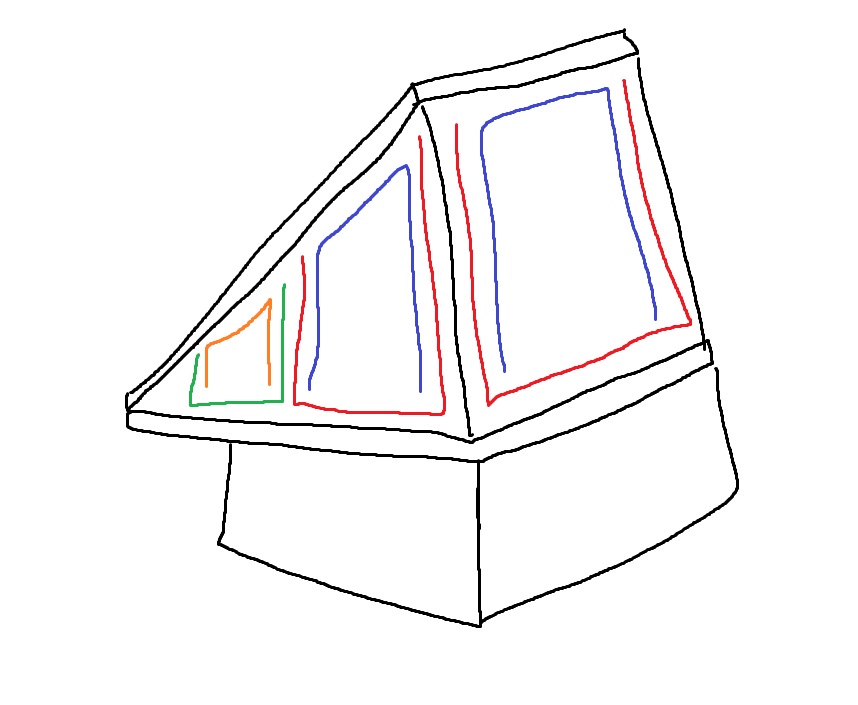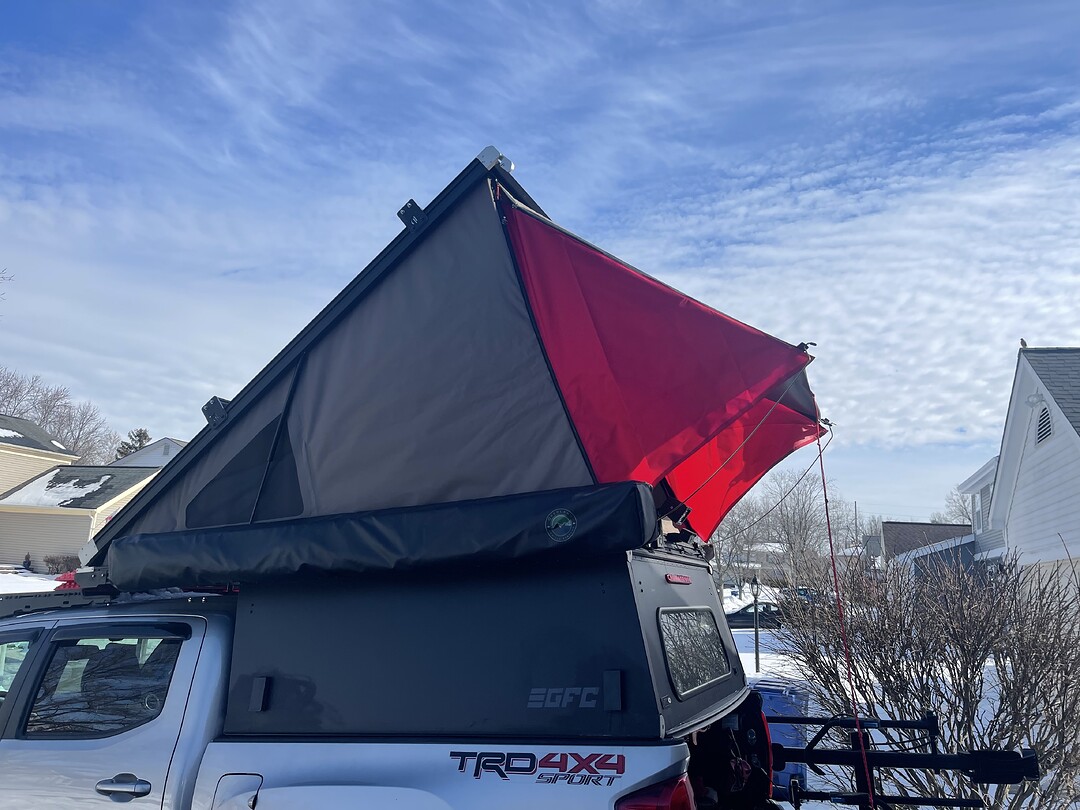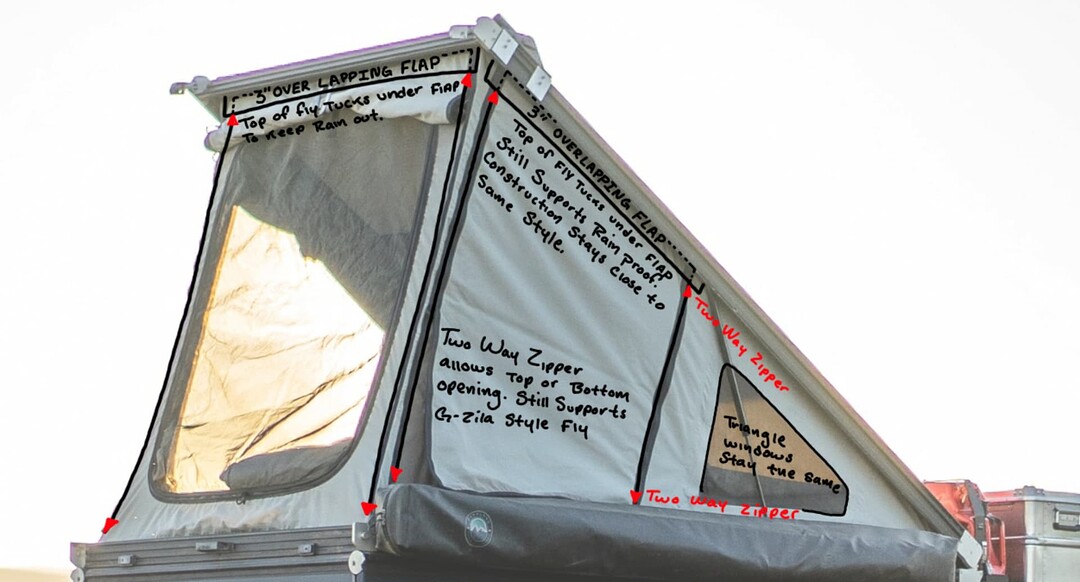I’m just here to say I wish I could have gone to the meet up. Next year.
Diesel heater mounting/passthrough solution. Or an entire first party solution.
Something along these lines.
in this order
- better mattress or @HEST mattress option
- a headliner
- better latches on the doors
- better powder coat
- rain fly on the tent
edit: I guess I can remove #1
@Buhlockaye lock covers have changed my mind on the locks now. So much better with the covers and less hassle with the dirt/mud/snow
Hey All!
First, you’ll find this post has been moderated to remain on topic.
Second, we intend to have meetups much more frequently than we have in the past; no need to wait until next year!
Most importantly, we appreciate the feedback on features, options, and accessories you’d like to see! Our team has a number of things in progress, and your feedback plays a large part!
Fully zipped doors are nice for some of the reasons mentioned here. Something we haven’t done an excellent job of communicating is the design intention around not making them fully sealed - providing passive ventilation.
Warmth in any single wall tent, whether it’s on the ground or on your truck, should first be found in your sleep system. The primary purpose of the tent is to protect you from rain and snow, rather than be an insulated space. Of course, with the recent proliferation of diesel heaters, we totally understand the desire to seal things up and capture that air.
Out of curiosity, would you like to see a retrofittable solution to seal the ventilation features of the tent for those using diesel heaters? Or would you prefer to trade cost, mattress thickness, ease of closure, and/or overall height of the RTT to fit a double-walled tent and reduce the draftiness?
In regards to the relatively open bottom areas of the doors, I’m fine with the extra ventilation and design of my V1 tent (#706). My velcro is wearing out, though, so I’d love to see snap or zipper upgrade to secure the short bottom panels. I’m not trolling for a free upgrade, btw. I’d be happy to pay and come to a Bozeman appointment to have my tent upgraded to be a little better.
Peace.
I first off want to say how awesome the GFC community is and this forum. It’s pretty hard to find a RAD group like we have here. It’s honestly one of the reasons why I purchased the GFC - there is NOT one other company who has such a sick community. A community that can connect, give advice, share amazing builds, and more. Literally this forum is built on the backs of the consumers - with them, this forum would be nothing.
Moving on…
I will speak on what I feel is the main concern of many folks (especially after chatting with other owners during the meet up). It comes down to ~ 2-3 factors:
-
How can we seal the tent when exposed to the elements AND
-
How can we vent the tent to mitigate some of the condensation issues when said elements are present (snow, rain, wind, etc.) AND
-
How can we also possibly have some privacy (zip down windows wink wink) + still allow airflow in the tent
I don’t hear many if anyone complain about the space frame, floor, strength of the shell, etc. Again, this is purely the tent design/window orientation layout. Everything else about the GFC besides the tent insert is RAD. I/many others don’t expect an Alucab for the price point of a GFC. However, these request are low hanging fruit that could truly excel the whole GFC product line.
If we can prevent the wind/rain/snow from entering the tent when camping in those extreme elements, that would lead to a “warmer” tent imo but correct me if that is wrong. There is a reason why folks who use the tent through all 4 seasons are making modifications to combat this issue such as adding maxair fans (@Julian has added this and many others), headliners (@Dogandagladiator has added this as well as @the_philxx and myself), or more. Being made in Montana, it should be expected that users are not only going to huck the heck outta this thing but camp in some pretty extreme elements.
While the passive ventilation is awesome, you have other competitors in the industry who are placing vents where the hot air is sitting/rising in the tent - the top back corner. Super Pacific has a very unique way of opening/closing their vent. This still allows some airflow if the tent has to be fully closed (or closed the best it can) in rain/snow. I get the triangles near the feet are supposed to help but again, my hot breath isn’t going towards my feet, it’s going to the top wedge. While these vents may not be the 100% solve all solution, from previous experiences with other RTTs, they do something and they help. I am no engineer but as an active user/camper with quite a bit of experience under my belt in various conditions…I can say for sure I miss the vents/window layout of other RTTs like the CVT Mt Hood. I think @nat3060 can even vogue for missing the sealed windows + vents of the iKamper. There is a reason why users are applying snap clips, velcro, etc. at the bottom of the windows - they want to be able to close the tent in this situations.
The user/consumer should have the ability to seal up the tent if they wish and vent the tent as they wish. Right now, we don’t have the ability to do so unless self done modifications are done which don’t always have the most success. Lastly, if we do make some of these modifications, we automatically void the warranty of the tent.
In response to this:
Out of curiosity, would you like to see a retrofittable solution to seal the ventilation features of the tent for those using diesel heaters? Or would you prefer to trade cost, mattress thickness, ease of closure, and/or overall height of the RTT to fit a double-walled tent and reduce the draftiness?
I personally don’t think there needs to be a double walled tent and after talking to some of the folks at GFC, it seems like there isn’t a true “doubled walled” RTT on the market (again, correct me if I am wrong on this). Not even Alucab, Super Pacific, or AT overland (as far as I am aware). It’s the weight of fabric being used or the material (marine grade, etc) being used that makes the difference especially after comparing the fabric used across companies. Certain materials like Polartec Power Shield w/windbloc membrane can block 99-100% of the wind - I don’t see how this would sacrifice the ease of closure, mattress thickness, or overall height of the RTT. Even if the overall height of the RTT had to increase 0.25 to 0.5in, it would open up so many more possibilities that probably many would opt for. Also, I highly doubt with the naked eye, someone would see 1/4 inch difference unless it was specifically pointed out. Again, I am not an engineer but I speak on real world experience. I use the heck out of your product and have real world experience - to me, that is something you can’t put a price on when looking for feedback, potential changes, etc.
So whoever is now running the forums or the official GFC forum profile, I hope you can take this as feedback. Yup, I am going to be the squeaky wheel on this matter because I truly care about the development and future of the company. It’s a RAD fudging company and I love supporting something so close and local… but when feet are dragged with updates/potential modifications, it’s frustrating. Take a stroll through these forums and YouTube videos/comments and I am sure you will find similar requests/or personal dilemmas on purchasing a GFC or RTT because of the above.



Glad to hear you are finally happy and enjoying your gfc! ![]()
IP 99000 waterproof solar plugs with plug on other side for solar charging without leaks or drilling. (OK, they don’t have to be IP 99000, but I’m too lazy to look up the real numbers). But make it easy to plugh in whatever solar is picked, and then inside plug to finish the deal for those of us to careful (OK, lazy) to drill holes in our rigs.
Handle on the upper back rail to grab easier for closing the tent.
Roof liner for when it is cold, to help keep condensation down. Or maybe even just make it with some Bed Rug type material on the ceiling of the tent. Would keep both light and condensation down. Although I hardly ever get any condensation, unless it is really cold and I’m totally zipped up.
Lock/latch covers stock, because the tailgate ones rusted up and wouldn’t open last year over the winter.
For me, I like single-walled and simple. But maybe have a double-wall tent for skiers etc who camp a lot in the winter.
snap in/velcro full insulation like:
Yea this would allow you to open the window and allow airflow when that light drizzle is happening. When/if it’s raining, I have found that most of the time you can’t have any of the windows open or else you’re going to get wet.
I would think that a two way window on either side would work quite effectively at providing privacy. With 1/2 of the canvas rolling up from the bottom you could enjoy ventilation and water rejection when up and great ventilation at night rolled down. The top portion would zip from the top down and have an expandable canvas inside that could be popped open to work as a vent that also offers protection from side gusting wind pushing rain inside the tent. When the two are zipped up completely it would offer superior protection from the elements without adding a lot of bulk or weight. The two things I am happy that the GFC doesn’t have. I owned a Tepui ruggedized Kukenam and that thing alone weighed more than my entire camper does.
Best of both worlds if someone were to take the time to design it properly.
Redesigning the windows would kill 2 birds with 1 stone here. Privacy + ventilation when warranted would be nice.
Let me start off by saying: I agree that condensation is an issue (heated blankets aside) and it stems from the fact that there is no ventilation at the top
But I am curious about how everyone envisions fixing the issue. I see a bunch of people talking about switching the tent doors from opening at the bottom to opening at the top. I do agree that this allows for the top of the door/window to be opened slightly without opening the whole thing, allowing some ventialtion. But this creates an issue for entry and exit. If the whole door and window open from the top, this means that the entire door needs to open for you to climb in from the outside. If it happens to be raining, then you have to climb over the door flap which could potentially let in a bunch of rain. The current tent setup allows for you to unzip the door a little bit and climb in underneath the flap.
Maybe this is what everyone is talking about: but it seems to me that the window mesh needs to be on the outside of the tent and the wall on the inside. The inside wall could then be unzipped from the top creating a window and allowing ventilation. But the whole tent door would still be opened from the bottom.
Hopefully that makes sense. And again, maybe that is what everyone has been talking about. I just find it hard to visually all of these different descriptions.

Here is a visual that I made in paint. As everyone is familiar with, the green corresponds to the mesh material in the front of the tent. The orange corresponds to the heated blanked flaps. Similar to the front, the red would be replaced entirely with a mesh material but it could still be zipped open to create a door. And the blue would become the tent material. This would allow for the blue to be zipped down from the top, but the entire red door could still be entered from the bottom.
This is a post we shared a while ago with our proposed revisions.
Here is the image I shared in there as well.
I’d love to see GFC start selling 3rd party items directly on their website, as well as at their installation locations. It took me quite a while to find many different components made by others for their campers. I’m sure I would have purchased a few items if they’d had them in stock when I picked up my GFC. I know many of these are small-batch items created at the time of order, but I’m also sure these smart people could find a way to help build the culture and ecosphere surrounding the GFC community.

